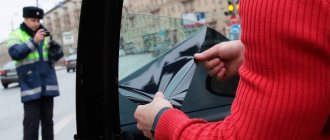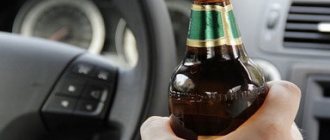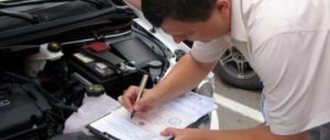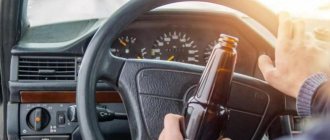What is a medical examination
A medical examination is a process of examining the general condition of a citizen for the presence of alcohol or drug intoxication. It is carried out by medical workers with a sufficient level of qualifications. Drivers are usually sent to it forcibly, in order to determine the concentration of ethyl alcohol in the blood. The grounds for prescribing an examination for a State Traffic Inspectorate employee are the following:
- Unconfident driving;
- Impaired speech or behavior during conversation;
- Reactions that are inappropriate to the environment or situation;
- Complete indifference to questions, lethargy;
- Swaying while walking;
- Strong odor of alcohol in the car or from the driver;
- Violation of rules when driving on the road;
- Detection of alcohol during exhalation using a special device - a breathalyzer.
All external signs of alcohol intoxication are clearly indicated in the law, and the inspector is guided only by them. Before being sent for a medical examination, it is proposed to undergo testing using a certified breathalyzer. It has a seal and a document confirming compliance with the standards established by law. Otherwise, the driver may legally refuse the measurement.
Step-by-step algorithm for checking a driver
The procedure for testing for alcohol by a traffic police officer in 2021 has its own characteristics. It begins with stopping the car and identifying characteristic signs of behavioral disorder. Only after the initial inspection, the inspector suggests performing the procedure for measuring alcohol in the exhalation. The driver has the legal right to refuse passage, but this will have its consequences. Alcohol testing is carried out in the following order:
- Explanation by the traffic police officer of the grounds for removal from driving.
- Inviting witnesses or starting video recording of the sequence of all actions.
- Checking the main reactions and measuring ppm. It uses a device to measure alcohol in exhaled air.
- Drawing up an inspection report based on the sample.
- A trip to the medical center for blood and urine tests. Carrying out the research procedure and drawing up a report.
The traffic police officer must take out a breathalyzer and demonstrate it to the driver for the presence of a seal, a certificate and unopened packaging of a disposable mouthpiece.
Only in this case can you trust the readings of the device. If the regulations are violated, then there is a high probability of an attempt to deceive the driver. A person is sent for a medical examination only if the alcohol concentration is above 0.16 ppm. At the blood test stage, its amount should be no more than 0.35, although relatively recently this figure was zero. The norm changed due to the unreliability of the device data after consuming products that do not contain ethyl alcohol. These include chocolates, kefir, kvass and non-alcoholic beer. Therefore, the maximum limit was increased, since 0.16 ppm is not capable of affecting the central nervous system.
Preparing for the examination
After the decision to conduct an inspection by the inspector is made, he must fulfill a number of legal requirements, failure to comply with which may subsequently lead to an appeal against the results of the examination and the driver’s punishment being cancelled. Preparation for an intoxication test begins with removing the driver from driving. To do this, the inspector must:
- Provide the reason for making this decision.
- Confirm that all further actions are recorded using a video recording device, or invite two witnesses who cannot be traffic police officers.
- In the presence of witnesses or while recording from a video camera, draw up a protocol on the driver’s removal from driving the vehicle.
Referral for medical examination
If the initial check shows alcohol intoxication, there are all its signs, but the driver is sure that he did not drink, only an examination can clarify the situation. It is carried out in a medical institution with a license to carry out such activities. If a person refuses to take it, he will automatically admit his guilt and will be deprived of his rights.
It is important to know! One measurement on a breathalyzer is not sufficient grounds for a court to leave a person without a driver’s license. Additionally, it is necessary to provide an alcohol intoxication examination report drawn up by a medical professional in the prescribed form. It reflects the obtained analysis results.
The procedure for testing for the presence of alcohol in the blood using a breathalyzer
To determine the state of intoxication, a breathalyzer is used, which measures the alcohol content in the exhaled air. The device must be in good working order and sealed, the mouthpiece must be sealed. The package should be opened before testing. The inspector must focus the driver’s attention on the serviceability of the device and mouthpiece. Alcohol may drip into the mouthpiece if it is not printed on you. In this case, refuse the examination and request a referral for a medical examination.
The procedure for checking a driver for alcohol intoxication assumes that the first air intake is carried out from the atmosphere and alcohol should not be detected in it. After this, the driver blows air into the mouthpiece until the sound signal.
The results shown by the device are demonstrated to the person being tested and the witness. After this, the results are printed in triplicate, one of which is given to the driver. Check the test time indicated on the printout - the device stores the data of previous measurements for some time. The maximum permissible alcohol content is 0.35 ppm, or 0.16 mg of alcohol per liter of exhaled air.
The rules for testing for alcohol in 2021 assume that the inspector does not have the opportunity to establish the fact of drug intoxication. For such a check it is necessary to conduct a medical examination.
When can you challenge the results of an examination?
The alcohol intoxication examination report is drawn up according to a sample, so many drivers think that it is impossible to challenge it. But this is far from true. If the accusation is false or the traffic police officer committed many violations during the process, then the document may be declared invalid in court and the citizen will be released from liability.
In what cases is it done:
- During the measurement process, a non-working or faulty meter was used, which produced two or more errors.
- There were no witnesses present when the document was drawn up; the inspection was carried out without video recording.
- The indicator is slightly higher than normal, which can always be attributed to the error of the device.
- The survey was conducted in an institution that does not have a license to carry out such activities.
- The driver behaved normally, there were no signs of intoxication, which is proven by the video, but the documents contained false information.
- In the medical examination report, the indicators are within the acceptable norm.
It is important to know! In this case, the document can be easily challenged in court. If the violation is repeated, and the person has previously been prosecuted under the article provided for by the Code of Administrative Offenses for driving while intoxicated, then minor deviations from the regulations will not be taken into account.
The traffic police told how mass sobriety testing of drivers is carried out
During the New Year and Christmas holidays, employees of the State Traffic Inspectorate of the Moscow Region, together with colleagues from the Moscow State Traffic Safety Inspectorate, continue to actively conduct mass sobriety checks of drivers.
In the first four days of 2021 alone, 136 drivers were brought to administrative responsibility for driving while intoxicated, and another 111 for refusing to undergo the appropriate medical examination.
It is noteworthy that literally on the eve of the holidays, that is, on December 30 and 31, 2021, the Moscow region traffic police conducted such checks. The essence of a mass check is to check the maximum number of drivers on a specific section of the road within a certain period of time, then move to other points and repeat the procedure.
Traffic police officers stop cars in predetermined places in special corridors marked with signal cones. At the same time, traffic inspectors assess the condition of each driver based on visual signs. If there are no signs of intoxication - the smell of alcohol, inappropriate behavior, incoherent speech, etc. - drivers will be immediately allowed to continue driving. If there are sufficient grounds to believe that the driver is intoxicated, the prescribed procedural actions will be carried out.
That is, no one will simply ask anyone to blow into the device. There is a certain order. To begin with, a driver who is suspected of driving while intoxicated must be removed from driving. This is done by drawing up an appropriate protocol, in the presence of two witnesses or by video recording. In this case, the grounds for removal must be indicated in this document. Next, a test for alcohol intoxication is carried out. This is just exhalation into a breathalyzer. The breathalyzer must have a printout function.
The driver may not agree to blow into the device on the road. This does not mean that he can be held accountable for refusing to undergo a medical examination. A roadside check is a procedure for testing for alcohol intoxication. Her testimony is accepted when making a decision only if the driver agrees with it. But the driver may doubt the readings of the device. The inspector has the same right. In this case, the driver must be sent for a medical examination. A protocol about this must also be drawn up in the presence of two witnesses or on video recording. And only a narcologist will decide whether the driver is drunk or sober. But if the driver refuses this procedure, he will be prosecuted precisely for the refusal. And the responsibility for this is exactly the same as for driving while intoxicated: deprivation of rights for one and a half to two years and a fine of 30 thousand rubles.
Mass checks on December 30 and 31, which were carried out by the traffic police near Moscow, ended in nothing. During these days, not a single person who was drunk or refused to be checked was identified. But the holidays probably relaxed drivers.
And in Moscow, mass checks took place on the night of December 28-29. In them, 109 people were found for driving while intoxicated, of which 56 drivers refused to undergo a medical examination for intoxication.
Also, traffic police officers detained two drivers who repeatedly drove while intoxicated, and who will subsequently be prosecuted for a crime under Art. 264.1 of the Criminal Code of the Russian Federation “Violation of traffic rules by a person subject to administrative punishment.”
Punishment for drunk driving
The law sets a standard of 0.16 ppm. It allows you to level out the possible error of the device, but does not give permission to drink right before the trip and avoid the consequences. A driver who is detained by a traffic police officer while drunk undergoes a medical examination and is held accountable.
The provided sanction is a fine of 30,000 rubles and deprivation of a driver’s license for up to 2 years. The punishment applies not only to the driver, but also to the owner of the vehicle.
Driving while intoxicated is a serious offense and entails administrative liability. In case of an accident involving a drunk driver, criminal penalties are implied. Therefore, you should not drive after drinking alcohol. Intoxication can be identified through a medical examination, which is ordered after an initial examination and drawing up a report on the spot.











